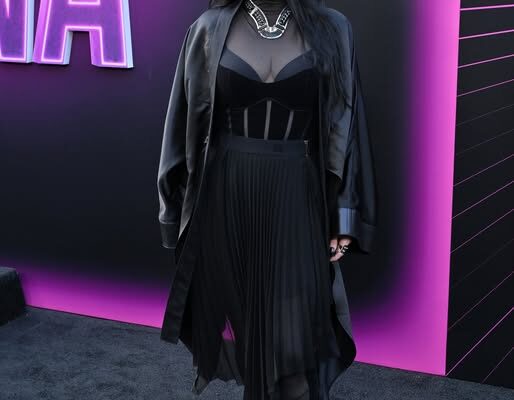“Is Amy Lee Still the Queen of Goth Rock—Or Has a New Generation Claimed the Throne?; because that will be”
Amy Lee, the ethereal voice behind Evanescence, has long been hailed as the queen of goth rock. Her rise to fame in the early 2000s coincided with a revival of gothic and symphonic elements in mainstream rock, where haunting melodies, dark lyricism, and powerful, operatic vocals captured the imagination of millions. With the release of Evanescence’s breakthrough album, Fallen, in 2003, Lee’s voice became emblematic of a generation searching for depth and emotion in rock music. Tracks like “Bring Me to Life” and “My Immortal” combined metal, classical influences, and introspective songwriting, creating a sound that was both commercially successful and artistically resonant. The impact was immediate; Lee was not just a frontwoman, she was a symbol of gothic intensity in a pop-oriented music world, someone whose artistic identity was inseparable from her visual and musical aesthetics. Her dark eyeliner, flowing black attire, and theatrical stage presence were extensions of a persona that felt both real and aspirational, inviting listeners into a world of shadowed beauty and emotional complexity. For many, Amy Lee’s reign as the queen of goth rock seemed unassailable, a throne carved out through talent, style, and cultural timing.
Yet, time has a way of shifting the landscape. Nearly two decades after Fallen, the musical and cultural terrain has changed dramatically. The goth rock scene, once a niche but visible corner of alternative music, has evolved into something less defined, influenced by the blending of genres and the rise of digital culture. Artists who might have once been confined to underground scenes now find themselves on global platforms, and a new generation of musicians—often younger, internet-savvy, and genre-fluid—has emerged. They embrace elements of goth rock, emo, and alternative metal, but fuse them with electronic sounds, rap influences, or bedroom pop sensibilities. The gothic ethos—the melancholic introspection, the romanticized darkness—remains, but it is interpreted in ways that differ from the early 2000s aesthetic Lee embodied. Musicians like Poppy, Ashnikko, and even Lil Peep in his posthumous influence, blend vulnerability with a gothic edge, reaching audiences who may not even be aware of the traditional goth rock canon. In this context, Amy Lee’s influence is undeniable, yet the throne feels less secure because the definitions of goth rock itself are in flux.
Amy Lee’s continued work with Evanescence shows both the endurance and the limitations of her reign. Albums like The Open Door, Evanescence, and more recent releases such as The Bitter Truth demonstrate that Lee is still capable of creating music that is emotionally powerful and musically ambitious. Her voice remains haunting and expressive, her piano-driven compositions retain their cinematic quality, and her lyrical exploration of love, loss, and inner turmoil continues to resonate with fans. Yet, some critics argue that Evanescence’s music has become a nostalgic echo rather than a frontier of innovation. While Lee’s artistry is respected, the sound she helped define has not always evolved in ways that keep pace with contemporary listeners’ expectations. The theatrical goth rock of the 2000s is no longer the only model of dark musical expression, and for younger audiences, the genre’s defining traits may come from newer artists whose work feels more immediate or experimental. In short, Amy Lee’s influence remains powerful, but the throne she occupies is increasingly symbolic, a link to the past rather than a reflection of the current mainstream goth rock scene.
The question of whether Lee remains the queen of goth rock also intersects with broader cultural dynamics. In the early 2000s, the archetype of the gothic female rock star was relatively rare, and Lee’s visibility was revolutionary. Today, there are more avenues for young women to explore alternative identities in music, thanks to social media and independent distribution. Platforms like TikTok, Instagram, and SoundCloud allow artists to cultivate aesthetic and musical personas without relying on traditional gatekeepers, and a younger generation is doing so with a gothic sensibility. This democratization of influence challenges the notion of a single reigning figure. Lee’s reign was built on mass media visibility and record sales in an era when such exposure was limited and highly competitive. Now, influence is decentralized, and cultural thrones are harder to occupy because attention is fragmented. The new generation of goth-adjacent artists might not match Lee in commercial dominance, but they are redefining the aesthetics, themes, and cultural impact of goth-influenced music, arguably creating a new crown for themselves in spaces that Lee never fully occupied.
At the same time, Amy Lee’s enduring fanbase demonstrates that her impact is not diminished by generational change. Fans who grew up with Evanescence still attend concerts, stream her albums, and engage with her online presence. There is a sense of loyalty and reverence for her artistry that newer artists have not yet cultivated, in part because the cultural moment Lee defined is impossible to replicate. Her blend of operatic vocals, gothic aesthetics, and emotional authenticity created a touchstone for countless listeners who were searching for a music that felt both dark and deeply personal. For many, she remains the archetype of the goth rock icon, a benchmark against which others are measured. Even as the musical landscape shifts, the emotional resonance and theatrical power of Amy Lee’s work maintain a form of authority that transcends trends. Her throne, then, is not only about current relevance but also about historical significance, the lasting imprint of a figure whose influence shaped an entire generation’s conception of goth rock.
Yet the emergence of new artists also highlights how goth rock has evolved. These musicians blend elements of vulnerability, visual aesthetics, and genre hybridity in ways that feel distinctly modern. They often employ social media personas, interactive performances, and multimedia storytelling to cultivate a gothic presence that is simultaneously intimate and performative. The melancholy, romanticized darkness that Lee championed is still present, but it is now expressed through glitchy production, hyperpop beats, and internet-influenced lyricism. In this sense, the throne of goth rock has become more contested, not through disrespect to Lee’s contributions, but through the natural evolution of a genre that thrives on transformation. New artists are claiming their own crowns, interpreting gothic sensibilities for a generation whose cultural touchstones differ from those of the early 2000s. This generational shift is not a dethroning in the literal sense, but a reimagining of what it means to occupy a position of influence within goth-inspired music.
Ultimately, whether Amy Lee is still the queen of goth rock depends on how one defines the term. If goth rock is about pioneering a fusion of metal, classical influences, and operatic vocals, Lee’s reign remains uncontested. If it is about cultural visibility, influence, and the shaping of a genre-defining aesthetic, her legacy is unassailable. But if the definition of goth rock expands to encompass the digital era’s hybridized, genre-blending expressions of darkness, then the throne is increasingly shared. Lee may no longer be the sole figurehead for younger audiences discovering gothic sensibilities for the first time, but her influence remains the foundation upon which this new generation builds. In a musical landscape defined by constant reinvention, Amy Lee’s artistry continues to shine, a reminder that the crown she forged may now be ceremonial in nature, but it is built from a legacy of undeniable talent, emotional depth, and aesthetic authority. The throne may have new claimants, but the queen’s mark on goth rock is indelible, a standard that will continue to inspire, haunt, and captivate for years to come.



